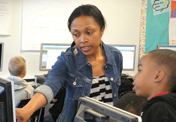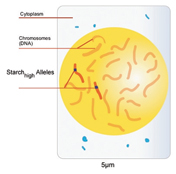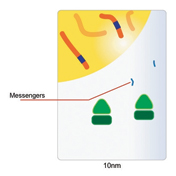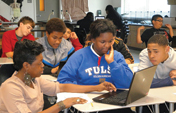Getting Kids Excited About Science
- Michelle Williams
- Associate Professor
- Department of Teacher Education
- College of Education

Wintril Maiden's 5th grade science class uses visualizations to learn about genetic inheritance in Fast Plants.
"How to engage kids—not only teach them content— but engage them, get them excited about science" is the passion of Michelle Williams. Dr. Williams is the principal investigator on a $2.3 million National Science Foundation grant to develop technology-based genetics curricula and assessments for 5th, 7th, and 9th grade students. "Genetics is very relevant to everyday life," said Williams. "Even if students don't go into science as a career, it can help them make better decisions about their own lives."
But studies show that students, even at the early college level, have some misconceptions about genetics.
So Williams and her team of mentor-teachers, principals, educational researchers, assessment experts, technology experts, scientists, and students are working with two school districts—East Lansing, Michigan, and Cedar Hill, Texas—to develop a curriculum package that improves kids' real-life understanding of genetics. This package includes an assessment component that allows teachers to see in "real-time" and long-term how their students are grasping and retaining the material, a technology component that allows students to visualize and interact with the material, and a professional development component that involves a mentor-teaching model, ensuring future sustainability of the curriculum.

"We couldn't do this without a collaborative. SRI International created great visuals on how traits are inherited and expressed. Our open-source programming platform resides at Berkeley. We have high school teachers on our design team. I have students with a background in measurement. We Skype all the time."
Williams oversees the curriculum development, incorporating ideas from her team of students, researchers, and teachers. The curriculum introduces progressively more complicated genetics concepts into each level.


The 7th grade curriculum uses familiar organisms such as rice to investigate genetic principles and solve problems.
At the 5th grade level, students learn fundamental concepts about heredity. Robert Voigt is a 5th grade teacher in the East Lansing School District. "Through reading, discussing, and actually growing little 'Fast Plants,' students come to experience that variations in plants and animals are common and are actually the rule, not the exception," Voigt explained. "Students learn that variations are caused by both genetics and the environment, and that such variations can actually have important consequences for the adaptation and survival of the species."
As students are introduced to the 7th grade curriculum the questions and activities become more challenging. Using a familiar organism, such as rice, students investigate genetics principles to solve problems, such as creating a more nutritious food supply. "In 7th grade it's more complicated," said Angela DeBarger, Ph.D., William's co-PI from SRI International (an independent nonprofit research institute in Menlo Park, California). "It gets more to the process of what's going on inside a cell."
Williams' goal is to help kids be prepared by high school to have a more sophisticated genetics repertoire to build on. "But we need to know better what they know and what they don't know," she added, "so we can develop materials that promote an integrated understanding of genetics."
Assessing Student Understanding
While Williams oversees the curriculum development, DeBarger leads the design of assessments in each of the units.
According to DeBarger, the two broad goals in designing the assessments are to help teachers assess whether students are understanding the concepts or are developing problematic or non-normative ideas (such as the belief that girls will always look like their mother and boys will always look like their father) and to help them be more reflective about their learning. Using embedded assessments to measure the impact of visualizations on student comprehension, teachers can determine students' immediate understanding and longer term knowledge retention.
Using Visual and Interactive Technology

Tasha Dixon engages her 7th grade students in learning about gene expression in plants and animals.
Using the Web-based Inquiry Science Environment (WISE) open-source platform developed in Berkeley, California, the team is able to create units with activities that build on each other, using a "predict-observe-explain" model. According to Williams, this helps kids sort out ideas and develop their reasoning processes. "Our goal is to build understanding and link ideas—to merge science and everyday life."
Each activity begins with a driving question, such as "Why do plants of the same species vary in how they look?" Then, using a number of innovative online tools, the kids—and teachers—are able to follow their progress. For example, the Idea Basket Tool gives kids the opportunity to formulate and defend their ideas. "The aim is for them to construct scientific explanations and use evidence to support their explanations," said DeBarger.
"The students loved it because it was so novel— offering online experiences including an online textbook, simulations, short video lessons and blogging opportunities," said Voigt. "It was a nice mix of classroom interaction, hands-on experience, and computer-based learning. I liked it because it was well thought out and allowed me to interact with the developers. I felt some ownership in the process."
Ensuring Sustainability Through Professional Development
The program is facilitated by mentor-teachers who support classroom teachers through model teaching and observations, professional development opportunities and team meetings. For example, Wintril Maiden, a mentor teacher in the Cedar Hill Independent School District in Texas, oversees the implementation of the Genetics Unit for 5th grade science. Maiden noted that "this program supports our curriculum by giving the students an inquiry-based, real-world activity in which to participate," she said. "The various activities that encompass the 5th grade unit allow the students to put the pieces of our driving question together and eventually understand and be able to express understanding through their responses and peer-interactions."
The project is in a continual process of refinement. "It's a good challenge," explained DeBarger. "This project is on the forefront of creating an approach for designing curriculum and assessments that are in line with Next Generation Science Standards (NGSS)."
As the project heads into its third year, Williams' team will be developing and preparing to implement a 9th grade curriculum that will encourage kids to think about a career in science. "By the time kids finish 9th grade," said Williams, "they should be able to understand the effects of genetics, the effects of the environment, and the combined effects of genetics and the environment on their lives."
For Williams, this project brings together her love of plant biology with her passion for teaching. She noted, "I enjoy working with real teachers and real kids in real schools and the collaborative nature of the work," adding, "I decided to focus on this because it's personally relevant—and it's a lovely way to teach science!"
- Written by Amy Byle, University Outreach and Engagement